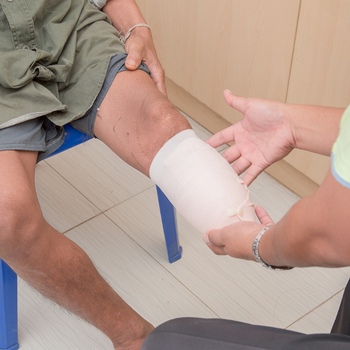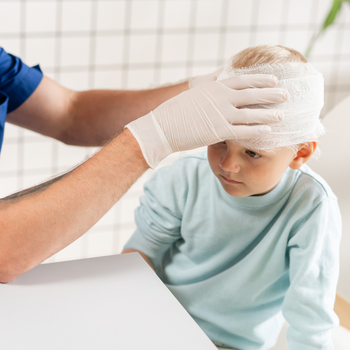A catastrophic injury has a range of definitions; it includes any loss of physical or mental ability from a catastrophic event. These injuries are life-changing for the person who sustains the injury. In personal injury law, we often see catastrophic injuries from various incidents like car and truck accidents, daycare abuse, or workplace injuries. We want to help our clients who suffer from these injuries get the help and closure that they need to move forward in life.
Common Types of Catastrophic Injuries
Brain Injury
There are many different kinds of brain injuries and many are caused by traumatic events. However, it is often difficult to see or know the symptoms of a brain injury right away—many times, people who sustain brain injuries seem like they are fine. It’s important to know the symptoms of a brain injury and to seek immediate medical attention if you think you might have one.
Spinal Cord Injury
.png) A spinal cord injury can change a person’s entire way of life—spinal damage, caused by a number of reasons, can cause a person to lose certain abilities due to damage to the spine and nervous system. Like brain injuries, spinal cord injuries may not be apparent right away.
A spinal cord injury can change a person’s entire way of life—spinal damage, caused by a number of reasons, can cause a person to lose certain abilities due to damage to the spine and nervous system. Like brain injuries, spinal cord injuries may not be apparent right away.
Burns
Because of the extensive reaction of the body, burn injuries often require expensive, intense medical treatments and procedures, long-term care, and extensive rehabilitation.
There are four classifications of burns, which are based on how deeply and severely the burn penetrates the surface of the skin. It is important to note that burn injuries can progress over time, so you may not be aware of a burn’s severity until a few days after the initial incident.
- First-Degree Burns: These burns only affect the outer layer of the skin, like a mild sunburn. The impacted skin may turn red and be painful upon touch, but there is no long-term impact on the body.
![Medical professional wrapping a person's leg after they were seriously burned.]()
- Second-Degree burns: Slightly more serious than first-degree burns, second-degree burns affect the outer and lower skin layers. For these burns, the skin may blister or swell. These burns are also painful to the touch.
- Third-Degree Burns: Affecting all three skin layers, third-degree burns are serious with lasting impacts on the body. These burns permanently damage nerve endings, hair follicles, and sweat glands. The skin may look black, white, or red with a leathery texture, and any pain will be felt in the areas around the burn.
- Fourth-Degree Burns: The most severe burn classification, fourth-degree burns go even deeper than third-degree burns and can be life-threatening. They permanently damage muscle, bone, tendons, and nerve endings in the impacted area.
Traumatic Amputation
.png)
Traumatic amputations are usually caused by some kind of accident or injury. if the limb is detached from the body and cannot be placed back on safely, a medical professional may recommend removing it completely. There are also partial amputations, where some of the soft tissue remains.
Chest Injury
.png)
A chest injury can cause a variety of different ailments, including fractured or broken ribs and lung damage. This can eventually lead to pneumonia or other potential infections of the lungs. Chest injuries are common results of direct trauma to the chest area; we see this often with victims of car accidents; however, they can happen as a result of a number of different physically traumatic events.
Bone or Joint Injuries
.png)
There are several types of trauma that can happen to bones, ligaments, and joints that can cause long-lasting injuries. These can be immediately apparent and extremely painful. There are many ways for a fractured bone to heal, but care should be taken to have the bone heal correctly. Joints that experience repeated or extreme trauma can wear down, causing worse injuries later on in life.
Vision Loss or Blindness
Vision impairment injuries are serious as they can immensely alter your daily life. If you have been injured in a If you are involved in a preventable accident that results in blindness or vision impairment, you have a right to file a claim to seek compensation and hold the negligent party accountable. Our personal injury attorneys at The Button Law Firm are dedicated to helping our clients file claims to get justice.
If you are involved in a preventable accident that results in blindness or vision impairment, you have a right to file a claim to seek compensation and hold the negligent party accountable. Our personal injury attorneys at The Button Law Firm are dedicated to helping our clients file claims to get justice.
At The Button Law Firm, we don’t charge you or collect any upfront fees to get started on your case.
Causes of Catastrophic Injuries
These types of injuries can happen for a variety of reasons. For example, the most common daycare injuries we see are a result of:
- Improper sleep methods - not properly putting a young child, like an infant or toddler, to bed can cause asphyxia, which can result in major brain damage or even death.
- Child abuse by a caregiver - caregivers who are not qualified or even dangerous can cause serious physical harm to young children. Slapping, pushing, or hitting a child can cause serious, long-term injuries.
- Not following procedure - if a caregiver does not follow the rules put in place by the daycare, a child can be seriously hurt. Just like in this case we handled with a bottle warmer full of scorching hot water falling on an infant's face.
- Neglect—When left alone, children can sometimes be a danger to themselves, whether through accidental self-suffocation or running and playing in an unsafe environment.
- Car accidents - a seemingly minor collision with another vehicle may cause serious damage to the drivers or passengers involved through whiplash, broken glass or blunt trauma.
- DWI accidents - accidents involving a drunk driver can lead to catastrophic injuries that may amount to worse results than your typical car accident due to improper use of a vehicle and negligence behind the wheel. DWI accidents also increase the risk of catastrophic injury to pedestrians and other bystanders due to the unexpected nature of a not sober driver.
- Trucking accidents - the size and weight of semi-trucks and delivery trucks make them especially dangerous to drivers. When the operator of a truck is acting negligently, a collision with their vehicle can leave another driver injured, paralyzed or even dead.


.png)




